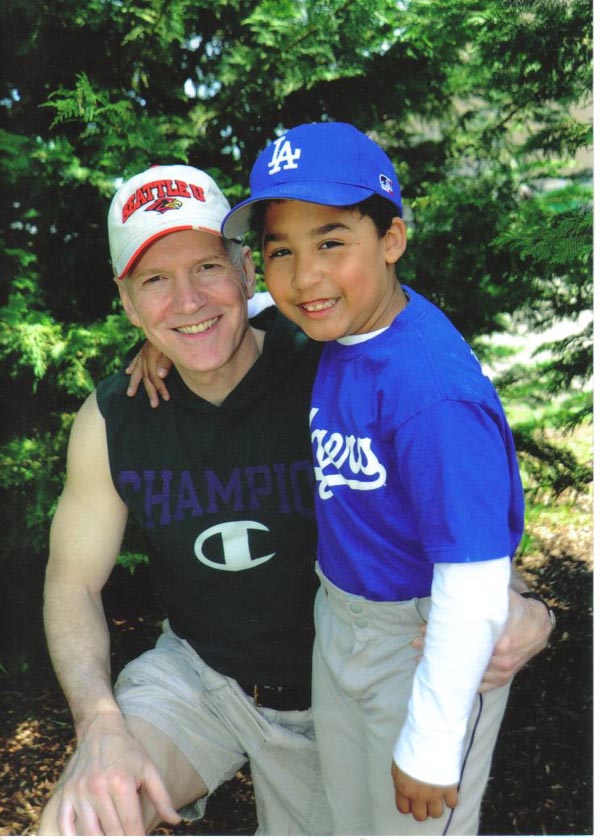CLAY MOYLE AND SON CALEB
A couple of months ago a friend of mine told me about a former professional boxer he knew that he urged me to contact. He thought I would enjoy speaking with the fighter and that I might get an article or more out of it. The fighter’s name was Stan Ward and he was a former California State Heavyweight Champion now in his mid-60s.
I was hesitant to call Stan because I was afraid he might be looking for someone to write a book about his life and career. I’ve come to learn writing a book is a very long time-consuming process and I’m getting pickier about what I’m willing to devote that much time toward.
STAN WARD
But, ultimately I decided to make the phone call. I liked Stan immediately and we’ve already spent three to four hours on the phone together over the course of a few interviews.
Stan is a very friendly, enthusiastic, positive individual with a great sense of humor. I’ve had a ball getting to learn a bit about his background and boxing career.
During our first conversation I was excited to learn he’d been a sparring partner for both George Foreman, when the champion was preparing to defend his title against Muhammad Ali in Zaire, and then for Joe Frazier as he prepared for his epic third battle against Ali in the Philippines. I suspected he’d have some great stories to share about those experiences and I wasn’t disappointed.
But, upon reviewing the notes of our conversations and reflecting a bit on what he’s told me, it occurs to me Stan has also strengthened a number of opinions I have concerning many of the traits I believe the majority of successful athletes share.
The first of the traits I noted Stan possessed was a desire to be great. He explained to me he was raised in an environment where you were expected to push yourself to the next level and to get outside your comfort level to accomplish that. As a result, when he decided he was going to become a professional fighter his ambition was to become the heavyweight champion of the world.
He didn’t accomplish that goal, but the important thing was he set his sights high and he did everything possible to try and achieve his objective. I believe the fact he set such a lofty goal for himself led to a very successful professional career (21-7-2) and helped him achieve the title of California State Heavyweight Champion. It also enabled him to have many experiences he might not have otherwise enjoyed, which have positively shaped his future and undoubtedly those he trains in the sport today.
I also realized Stan’s success was built upon a strong foundation of fundamentals. He was fortunate enough to receive some terrific coaching concerning the basics of boxing in the form of footwork, catching, blocking and slipping punches, head movement and conditioning that helped him avoid taking unnecessary punishment in the ring, and survive brutal sparring sessions against the likes of Foreman, Frazier, and Ken Norton as he was honing his craft.
Regardless of the sport, it’s obviously critical that an athlete master the fundamentals. And as Stan explained, “Learning is in doing. A lot of times you see something but until you do it you don’t get the understanding and meaning.”
That was something his father taught him.
“He told me that a lot of things you see in life you may not understand, but if you allow your mind to record those actions and those movements, and you go back and repeatedly duplicate them physically, your mind and body will absorb the movements and you’ll begin to understand.”
I couldn’t agree more. That’s something I repeatedly tell kids I work with on their basketball skills. You need to learn the proper way to perform a skill and then you need to repeat it over and over again until it becomes second nature.
I’ve always told kids that for every hour I spend working with them on any particular skills they should spend another three or four hours working on those things on their own if they really want to get good at it. But, in my experience it’s a rare individual that is willing to pay that kind of price.
Another trait Stan exhibited early on was what he referred to as moxie. Moxie is defined as force of character, determination, or nerve and I think it’s fair to say Stan had a lot of that.
A prime example of that was the story he told me about driving to the training camp of the reigning heavyweight champion of the world, big George Foreman, as he began to prepare to defend his title against Muhammad Ali. Stan heard George was looking for sparring partners and despite the fact he’d only had one professional fight himself he didn’t hesitate to apply for the job.
It took a lot of nerve to do something like that, but Stan knew where he wanted to go and he was willing to do whatever it took to get to the next level.
So, Stan drove right down to Foreman’s training camp and asked George’s manager for an opportunity to audition to become one of his sparring partners. Foreman’s manager, Dick Saddler, told Stan he had a lot of nerve asking to spar against George given his limited experience, but agreed to give him a tryout.
When Stan witnessed the poor fellow that Foreman was sparring with right before him get knocked through the ropes and land on his back outside the ring, he had the guts and determination to climb into the ring when Foreman’s handlers hollered out “NEXT!”
Stan was willing to take that step because of his ambition to become a world champion himself, and another little secret to success that he was aware of. You see, Stan realized that one of the best ways to get better yourself is to compete against others who are better than you are. What better way for him to gain an understanding of what it took to become the world heavyweight champion and improve himself than to spend time in their training camp, sparring against them daily and watching how they train and prepare themselves for a bout?
He not only survived that initial sparring session, but impressed the men enough that he was hired to become one of George’s sparring partners.
When Stan traveled with Foreman to Zaire, Africa and the opportunity presented itself, he not only studied Foreman but watched many of Muhammad Ali’s sparring sessions as well.
This is something my own father drilled into my head early on as well, in terms of sports. Whenever possible, complete against better ballplayers to learn more about the skill sets they possess and what you need to improve upon. Its great advice and something I’m constantly telling my own son.
When Stan began sparring with Foreman he’d already had an opportunity to watch him in action/ He made sure he had a plan for himself when he entered that ring. The primary piece of that plan was to live to see another day. George wasn’t the smiling jolly fellow that many came to know later in his career. No, at that time he was a moody, sullen, menacing big strong man who Stan said treated his sparring partners as enemies and was trying to knock their blocks off.
But, when Stan climbed through the ropes that day he was intent on making sure that he kept moving, and he made sure to move a split second before George planted his feet and threw his punches.
When George cut the ring off and started throwing big looping hooks in Stan’s direction he initially decided to block them. But, when he blocked the first hook and was sent careening all the way across the ring he decided blocking wasn’t going to work. So, he decided he’d try and tie George up to prevent him from throwing punches, but Foreman was too strong for that. So, Stan reverted to boxing again.
The point here is that you need to have a plan before you enter into competition and when that plan doesn’t work you need to adjust and try something else until you find something that works. So many times over the years I can think of examples where a game plan of a coach, or a competitor, didn’t work and they didn’t try something different.
I believe it was Albert Einstein who is credited with the saying that the definition of insanity is doing the same thing over and over again and expecting different results.
Stan learned something new each day he sparred with George and started to identify what kind of punch George was going to throw next by the way he positioned his body. It wasn’t long before Stan was able to anticipate which punch was coming next. That didn’t mean he could always avoid each punch, but at least he could start moving away from the punch to diminish its impact.
Obviously the recognition of your opponents’ tendencies and successful anticipation of their next move is a tremendous aid in one’s ability to counter or defend against that move. I can still hear my old high school coach Dean Scherer hollering at us to “Anticipate!” as he coached us from the sidelines.
I believe a couple other keys to the success Stan enjoyed over the course of his career were a result of his ability to focus on the task at hand and control his emotions as he entered the ring. As he explained to me, prior to entering a contest he made sure to spend some quiet time, often in front of a mirror, concentrating on the things he planned to do once he faced his opponent, and mentally composing himself.
Stan explained he knew many fighters who looked great in the gym that lost their composure and forgot everything they knew once they found themselves in a real fight before a crowd. I’ve seen similar examples of this in terms of athletic competitions myself over the years, and while I believe the ability to maintain my own composure was a strength for myself as well in any of my own youthful athletic endeavors, I didn’t always succeed in that effort as well as I would have liked on occasion.
Stan has always believed the ability to control his own emotions was one of his greatest assets during his boxing career. I’m sure he credits taking the time to compose himself and focus on what he wanted to do before entering competition with his success in that area.
I suspect that many, if not all of these traits would be found in the majority of individuals who have enjoyed athletic success in their careers and provide a blueprint of sorts to others who wish to follow in their footsteps.



